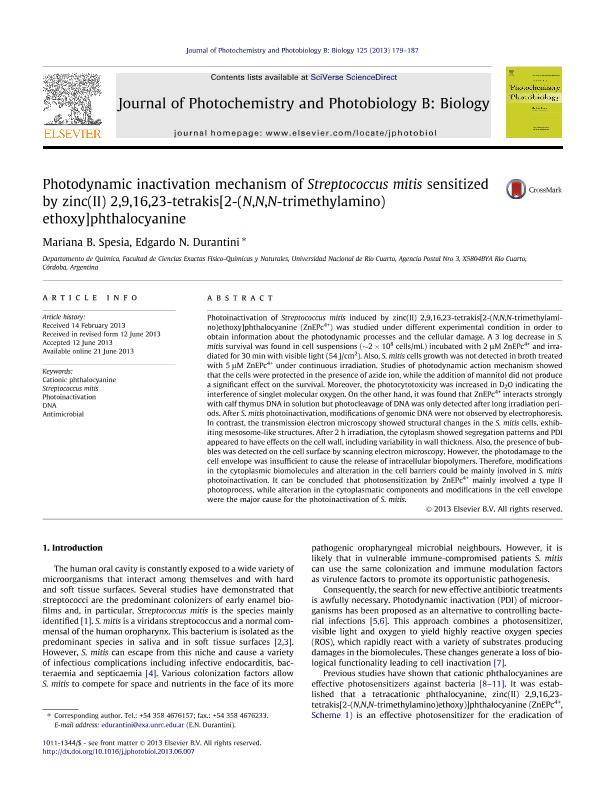Artículo
Photodynamic inactivation mechanism of Streptococcus mitis sensitized by zinc(II) 2,9,16,23-tetrakis[2-(N,N,N-trimethylamino) ethoxy]phthalocyanine
Fecha de publicación:
06/2013
Editorial:
Elsevier
Revista:
Journal of Photochemistry and Photobiology B: Biology
ISSN:
1011-1344
Idioma:
Inglés
Tipo de recurso:
Artículo publicado
Clasificación temática:
Resumen
Photoinactivation of Streptococcus mitis induced by zinc(II) 2,9,16,23-tetrakis[2-(N,N,N-trimethylamino)ethoxy]phthalocyanine (ZnEPc4+) was studied under different experimental condition in order to obtain information about the photodynamic processes and the cellular damage. A 3 log decrease in S. mitis survival was found in cell suspensions (∼2 × 108 cells/mL) incubated with 2 μM ZnEPc4+ and irradiated for 30 min with visible light (54 J/cm2). Also, S. mitis cells growth was not detected in broth treated with 5 μM ZnEPc4+ under continuous irradiation. Studies of photodynamic action mechanism showed that the cells were protected in the presence of azide ion, while the addition of mannitol did not produce a significant effect on the survival. Moreover, the photocytotoxicity was increased in D2O indicating the interference of singlet molecular oxygen. On the other hand, it was found that ZnEPc4+ interacts strongly with calf thymus DNA in solution but photocleavage of DNA was only detected after long irradiation periods. After S. mitis photoinactivation, modifications of genomic DNA were not observed by electrophoresis. In contrast, the transmission electron microscopy showed structural changes in the S. mitis cells, exhibiting mesosome-like structures. After 2 h irradiation, the cytoplasm showed segregation patterns and PDI appeared to have effects on the cell wall, including variability in wall thickness. Also, the presence of bubbles was detected on the cell surface by scanning electron microscopy. However, the photodamage to the cell envelope was insufficient to cause the release of intracellular biopolymers. Therefore, modifications in the cytoplasmic biomolecules and alteration in the cell barriers could be mainly involved in S. mitis photoinactivation. It can be concluded that photosensitization by ZnEPc4+ mainly involved a type II photoprocess, while alteration in the cytoplasmatic components and modifications in the cell envelope were the major cause for the photoinactivation of S. mitis.
Palabras clave:
Phthalocyanine
,
Photosensitizer
,
Photodynamic Inactivation
,
Bacteria
Archivos asociados
Licencia
Identificadores
Colecciones
Articulos(CCT - CORDOBA)
Articulos de CTRO.CIENTIFICO TECNOL.CONICET - CORDOBA
Articulos de CTRO.CIENTIFICO TECNOL.CONICET - CORDOBA
Citación
Spesia, Mariana Belen; Durantini, Edgardo Néstor; Photodynamic inactivation mechanism of Streptococcus mitis sensitized by zinc(II) 2,9,16,23-tetrakis[2-(N,N,N-trimethylamino) ethoxy]phthalocyanine; Elsevier; Journal of Photochemistry and Photobiology B: Biology; 125; 6-2013; 179-187
Compartir
Altmétricas




